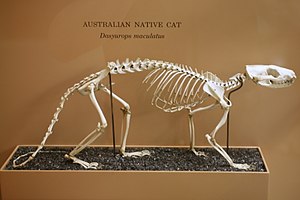Skeleton of an elephant
Skeleton of a tiger quoll (Dasyurus maculatus).
The proportionately thicker bones in the elephant are an example of allometric scaling
The proportionately thicker bones in the elephant are an example of allometric scaling
Allometry (Ancient Greek ἄλλος állos "other", μέτρον métron "measurement") is the study of the relationship of body size to shape,[1] anatomy, physiology and behaviour,[2] first outlined by Otto Snell in 1892,[3] by D'Arcy Thompson in 1917 in On Growth and Form[4] and by Julian Huxley in 1932.[5]
- ^ Small, Christopher G. (1996). The Statistical Theory of Shape. Springer. p. 4. ISBN 978-0-387-94729-7.
- ^ Damuth J (February 2001). "Scaling of growth: plants and animals are not so different". Proc. Natl. Acad. Sci. U.S.A. 98 (5): 2113–4. Bibcode:2001PNAS...98.2113D. doi:10.1073/pnas.051011198. PMC 33381. PMID 11226197.
- ^ Otto Snell (1892). "Die Abhängigkeit des Hirngewichts von dem Körpergewicht und den geistigen Fähigkeiten". Arch. Psychiatr. 23 (2): 436–446. doi:10.1007/BF01843462. S2CID 30692188.
- ^ Thompson, D'Arcy W (1992). On Growth and Form (Canto ed.). Cambridge University Press. ISBN 978-0-521-43776-9.
- ^ Huxley, Julian S. (1972). Problems of Relative Growth (2nd ed.). New York: Dover. ISBN 978-0-486-61114-3.

